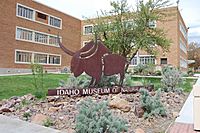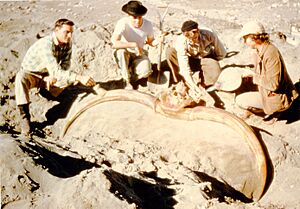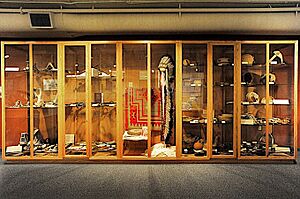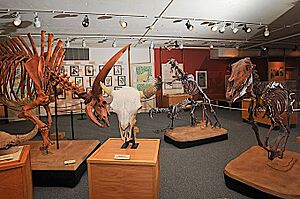Idaho Museum of Natural History facts for kids

The Idaho Museum of Natural History on the ISU Campus
|
|
| Established | 1934 |
|---|---|
| Location | Pocatello, Idaho, United States |
| Type | Natural history museum |
The Idaho Museum of Natural History (IMNH) is Idaho's official state museum for natural history. It is located on the campus of Idaho State University (ISU) in Pocatello. The museum started in 1934. It holds amazing collections about people (anthropology), ancient animals (vertebrate paleontology), Earth's rocks and land (earth science), and living things (life sciences). It also has old documents and photos of different cultures.
Contents
History of the Museum
The Idaho Museum of Natural History began in 1934. A group of professors and researchers wanted to collect and show Idaho's natural and cultural treasures. It was first called the Historical Museum.
At the start, the museum had about 5,000 items. Most of these were artifacts from people and history. They were given by the Pocatello Chamber of Commerce and university supporters.
The museum changed its name a few times. In the mid-1950s, it became the Idaho State College Museum. Then, in 1963, when the college became Idaho State University, the museum also changed its name to the Idaho State University Museum.
In 1977, the museum started focusing more on natural history. Many collections of plants and animals moved from the university's science department to the museum. The museum also received historical items from other societies and the university library.
Later in 1977, Idaho's Governor John V. Evans officially named it the Idaho Museum of Natural History (IMNH). In 1986, the state of Idaho confirmed IMNH as its official state natural history museum.
What the Museum Does
The Idaho Museum of Natural History helps people understand and enjoy Idaho's nature and history. As the state's official natural history museum, it collects, protects, studies, and shows natural and cultural items. It does this for people in Idaho, visitors, and students around the world. The museum also helps other natural history museums in Idaho.
Museum Collections
The IMNH has over 500,000 items in its collections! The museum gathers and keeps records of Idaho's natural history. Its collections are split into three main areas: people (anthropology), Earth's history (earth sciences), and living things (life sciences). Most items were found and studied by students and staff from Idaho State University.
Anthropology Collection
Anthropology is the study of humans. This includes how different cultures live, ancient human sites (archaeology), languages, and how humans have changed over time. The museum's anthropology collection mostly focuses on Idaho. It has human artifacts from the end of the last Ice Age to modern beadwork. These items offer many ways to learn and research human history.
Earth Science Collection
The earth science collection focuses on rocks, minerals, and fossils. These items help us study ancient life (paleontology), how Earth is made (geology), ancient plants (paleobotany), and animal bones.
Life Science Collection
The life science collection includes studies of living things. This means plants, animals, and humans. The museum's life science collection is one of the most complete collections of Idaho's living creatures. The Ray J. Davis Herbarium has over 70,000 dried plants, mosses, fungi, and lichens. The animal collection has about 1,200 mammals, 1,800 birds, 2,500 reptiles, and 1,000 fish.
Museum Exhibits
The exhibits at IMNH come directly from the museum's collections. They help tell the story of the natural and cultural history of the area.
Anthropology Exhibits
The anthropology exhibits show the people of Idaho, both from the past and today. They show how Idaho's people lived, survived, and used the land, plants, and geology of Idaho. These exhibits include cultural items, ancient tools, copies of artifacts, old and new photos, and recordings in several Native Idahoan languages.
Earth Science Exhibits
The Earth Science exhibits teach us about Idaho's geology, ancient animal tracks, and huge Ice Age animals. The Idaho Geology exhibits show many items from minerals to fossils. You can learn about Idaho's geology with hands-on activities. The Trackways exhibits show ancient footprints left in sandstone by animals. You can see footprints from spiders, dinosaurs, and early mammals. The Ice Age Megafauna exhibits show the area's fossil history. You can see skeletons of large prehistoric creatures like saber-tooth cats, giant bison, and the Hagerman horse.
Life Science Exhibits
The Life Science exhibits highlight the many different plants and animals of the Snake River plains. Some items on display include various rodents like flying squirrels, kangaroo rats, beavers, and marmots. You can also see owls and sage grouse. The exhibits also show a wide range of native reptiles, amphibians, and fish from Southern Idaho. Finally, the Ray J. Davis Herbarium allows IMNH to show many native plants, some of which are now extinct. Plants on display include the yellow glacier lily, camas, syringe, and more.
Role of Idaho State University
The IMNH was created by Idaho law. Its main goal is to show Idaho's natural history. It collects, protects, studies, and displays natural items. It also provides educational services for people in Idaho and visitors. The museum also helps other local natural history museums across the state.
Besides showing exhibits, IMNH is also used for learning and research. Students at Idaho State University can study many of the items in the museum's collections.





